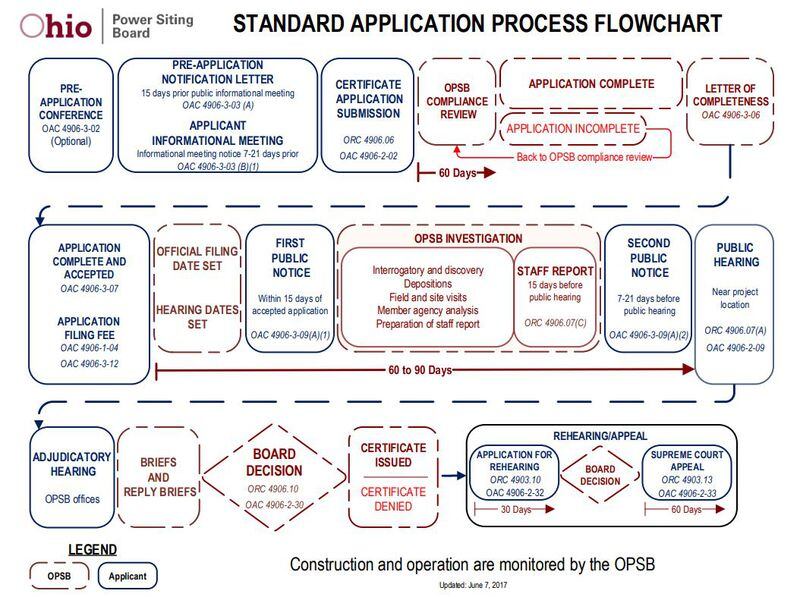Application for controversial solar farm estimates multi-million dollar impact for Greene
Staff can request additional information if they feel an application is not complete.
Once an application is deemed complete, the OPSB board sets a procedural schedule for the case, including dates for the Staff Report of Investigation, the local public hearing and the evidentiary hearing. During the staff investigation stage, the OPSB staff scrutinizes the plan, visits the site, issues data requests to the developer and then makes recommendations to the board members in a report.
After the OPSB staff files this report, the local public and adjudicatory hearings are held.
These hearings enable citizens, interest groups and governmental entities to present testimony.
The public will be notified when the application from Vesper is deemed complete and the dates for the hearings will be outlined in the notice.

This flow chart shows the Ohio Power Siting Board process. CONTRIBUTED
Greene County commissioners earlier this month held a town hall to hear residents’ thoughts on the potential solar project. Those in attendance were overwhelmingly against the project coming to Greene County.
County Administrator Brandon Huddleson said the commissioners are still reviewing the application and plan to put together a list of questions about it in the coming weeks.
Several residents said they would be surrounded on several sides by panels and didn’t want that to be their view. Many also spoke about the reasons they chose to move to the area. Residents also expressed concerns about how solar panels could affect wildlife, drainage and the impact on the soil and water tables.
According to the Utility Scale Solar Energy Coalition of Ohio, a pro-solar organization, solar farms don’t cause air pollution or water pollution, and there are no chemical emissions. As part of the siting process, Vesper must conduct environmental assessments on how their development would impact the area.
Vesper’s application included about 20 appendices and studies on the impact the project will have on the area.
The visibility study included with the application states the solar panels will not be visible from John Bryan State Park. The project will be visible to people who enter Clifton Gorge, but likely not visible once inside the forested area. The study states the panels would potentially be visible from the Little Miami River and the Little Miami Scenic Trail. The study states the solar project would likely not significantly alter the landscape in the areas solar panels will be.
A sound study also states there likely won’t be much noise added to the area, and what noise is added in the area is less than the five decibels permitted by the PUCO.
A property value study attached to the application stated that it found there was “no measurable and consistent difference in property values for properties adjacent to solar farms when compared to similar properties locationally removed from their influence.”
CohnReznick, a consulting firm based in Chicago, did the study on solar projects in Michigan, Indiana, Florida, North Carolina, Virginia and Minnesota. Due to the limited information available to study within Ohio, they studied similar utility-scale solar farms in these states.
The firm also interviewed local real estate brokers who stated that there is no difference in price, marketing periods or demand for the homes directly adjacent to the solar farm facilities they studied. The study found in the states examined the properties nearby “were not adversely affected by their proximity to solar farms, that properties surrounding other solar farms operating in compliance with all regulatory standards will similarly not be adversely affected, in either the short- or long-term periods.”
The estimated cost to develop Kingwood Solar is $196 million, including direct and indirect costs, and the construction timeframe is anticipated to be 16 months, from June 2022 through September 2023. The operational lifespan of Kingwood Solar is expected to be 35 years, an economic impact study done by Silverlode Consulting states.
Construction will require an average of 225 construction workers working on-site for 16 months; 80% of the construction workers will be Ohio residents.
Earnings associated with Ohio construction workers is estimated to be $16 million, the economic impact study states.
Local construction workers will be utilized to the extent available, but a portion of the construction workers will travel to the site and will stay in local hotels on a long-term basis, resulting in significant food and lodging spending within the local economy during construction.
The annual operations of the Kingwood Solar project will create four high-paying permanent full-time equivalent jobs, the study states. The annual payroll, including benefits, associated with the jobs is estimated to be $443,000. An estimated 440 direct, indirect, and induced jobs will be supported during the construction of the project and 23 permanent direct, indirect, and induced jobs will be supported by ongoing operations.
Kingwood Solar will generate $4.32 million in state and local taxes in Ohio during the construction period, the study states.
Read More: Application for controversial solar farm estimates multi-million dollar impact for Greene

